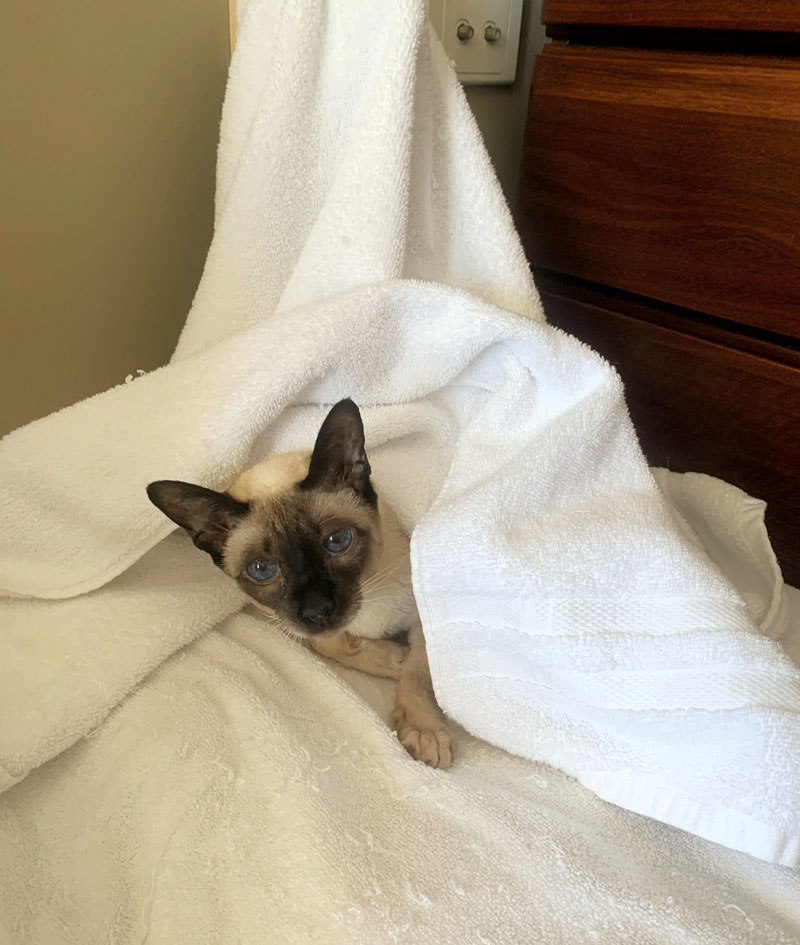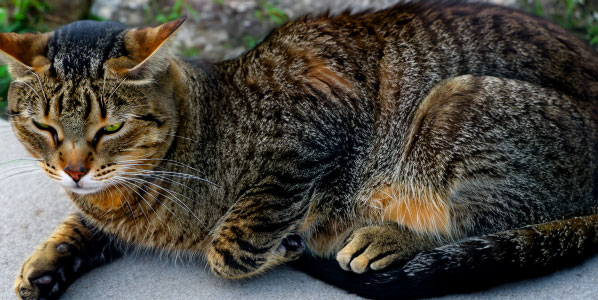Yes, it’s still summer but does the COLD WEATHER make your cat FREEZE UP? Has she stopped leaping gracefully onto the bench? Getting grumpy? Our feline friends are renowned for their agility, litheness and jumping ability.
Dr Kim was taught – last century – that cats did NOT get arthritis. Probably because cats did not live very long, and till effective pain relievers (that didn’t kill the cat..) were developed so the difference could be seen. Turns out, many cranky cats are just in pain.
Check out this checklist: www.zoetispetcare.com/checklist/osteoarthritis-checklist-cat
Research now shows that cats DO get arthritis, and, like a lot of athletes, can have joint
problems from a young age. In fact, 30% of cats have arthritis by the age of three years old (that’s only 28 human years!)! And 90% of cats by 10 years old! After masses of work done in people and dogs, it is now known that there is no correlation between bony changes seen in Xrays and the amount of pain felt by the person. Pain has no standard scale – some people (and cats) are stoics, and others are very sensitive. It is just part of what makes us all individuals!
Pain management in all animals is now a hot topic, and there are some terrific new drugs that make cats feel so much better, they start jumping on the kitchen bench again! If your cat will not jump more than 1 metre high – or stops and looks, to gather themselves before they do – and has started ‘clawing’ their way onto the bed instead of that lithe, graceful leap, then no matter what the age, your cat is telling you something – my back or my joints just HURT. If her nails are getting thickened or growing around into the pad – that’s arthritis too!
The recent options for treatment are broad-ranging and beneficial, and Dr Kim can customise them for your cat’s problem and metabolism. Growing old is inevitable, and growing old comfortably is the key to a pleasant senior cat’s life journey.
The simplest assistance – stairs or chairs halfway up to jump on, heat pads (electric and wheat packs are great) and igloos for warmth. Have a look at the comfort of these girls! (picture of towel igloos) Cats actually prefer the room temperature to be 30 – 38 degrees Celsius! No wonder they are such sun-seekers!

Treatments
If the bones really start to grind together, and there is no medical mending, then your feline friend may need further medication.
In the early stages, or just as a general supplement, there is Omega-Joint tablets – so tasty most cats will eat them straight out of the bowl (truly – cat-tested here!). It is a non-fish source of Omega-3’s (we should all be on massive doses of Omega-3’s apparently!) and has really enlivened some felines up nicely. There are also glucosamine supplements like Blackmores PAWS and Sasha’s Blend that work for some cats. RoseHip Vitale has some reasonable evidence and some cats will eat the powder in their food or it can be given as a capsule. 4-cyte, Atinol and Seaflex are worth trying out as well.
Moving up the intensity scale, there is the Cartrophen injections – a series of injections once a week for 4 weeks and then a monthly top-up that keeps cats supple! When it works, it works very well, and if it doesn’t, it does no harm. Developed for racehorses to keep them ‘on track’ our cats can also benefit.
Acupuncture done for us by Dr Barry Nielsen, www.felinefriendlycare.com/for-vets/vet-videos is a wonderful relief for a lot of cats – about 80% loosen up after one treatment. Dr Barry uses a slight variation on the traditional acupuncture technique (called aquapuncture)- he injects a small amount of vitamin B12 into the acupuncture points, especially along the spine. He uses a nice light sedation so the cats are relaxed and not worried, plus they get a full massage. Again, when it works the effects last 6 – 12 months, sometimes longer!
The concept of blocking just the nerve pain signals (rather than trying to reduce inflammation) has shown that Gabapentin, and some opioids, like Tramadol, and buprehophine are helpful but do make some cats ‘weird’ or ‘too sleepy’.
Ketamine microdose injections also block the pain pathway to the brain and allow a cat to be more mobile. Some cats get an hour or so of euphoria just after the injection, and then they seem to be able to find a sleeping position more comfortably and easily. It needs monthly repeats, which can be done at home or at the Palace.
But the new star on the nerve-blocking front is Solensia. It blocks the pain-to-brain pathway via blocking Nerve Growth Factor that is induced by the inflammation in the joint. It is so specific, Dr Kim uses a couple of injections of it to diagnose osteoarthritis – much better than x-rays or even manipulation of joints etc. When it works – cats become kittens again. Running around and playing like they haven’t in years. When it doesn’t work, it means the pain comes from somewhere other than joints and a bit of a search for other sources (eg gut pain from IBD, muscle weakness, bone cancer) is needed to make your cat comfortable again.
Part of the reason we know so many cats have pain from the inflammation of arthritis, is that there are now several NSAIDS (non-steroidal) medications that do not kill the cat! Depending on the state of their kidneys, and general health, there are several options. Onsior has been approved for long term use in cats, and Meloxicam has even been shown to prolong cat kidney health! Cortisone, in the form of Prednisolone, was the only anti-inflammatory medication available for many years, and is still useful for joint pain (it CANNOT be used with NSAIDS) but usually only as a by-product of its use for other problems like allergies.
Nutrigenomics (you are what you eat!): Foods incorporating nutrients for joints (eg Royal Canin Mobility, Hills J/D) are also effective
www.veterinarypracticenews.com/nutrigenomics-takes-you-are-what-you-eat-to-new-level
Any one, or a combination, of these products can help your cat to be once again ‘feline fine’ and moving more like a cat should! And don’t forget the good old heat mat – there are many makes and models around and it does make a difference!
So, if your cat can’t jump 1 metre high in a smooth, elegant leap, finds steps (up or down) a chore, has gotten cranky about grooming, maybe even developed little knots or tufts in their coats, then speak to Dr Kim about arthritis. It is a big part of a Senior Health Check! and she checks every cat, every time.
Dr Kim strongly supports the concept of Cat Comfort Coming FURR-st.



